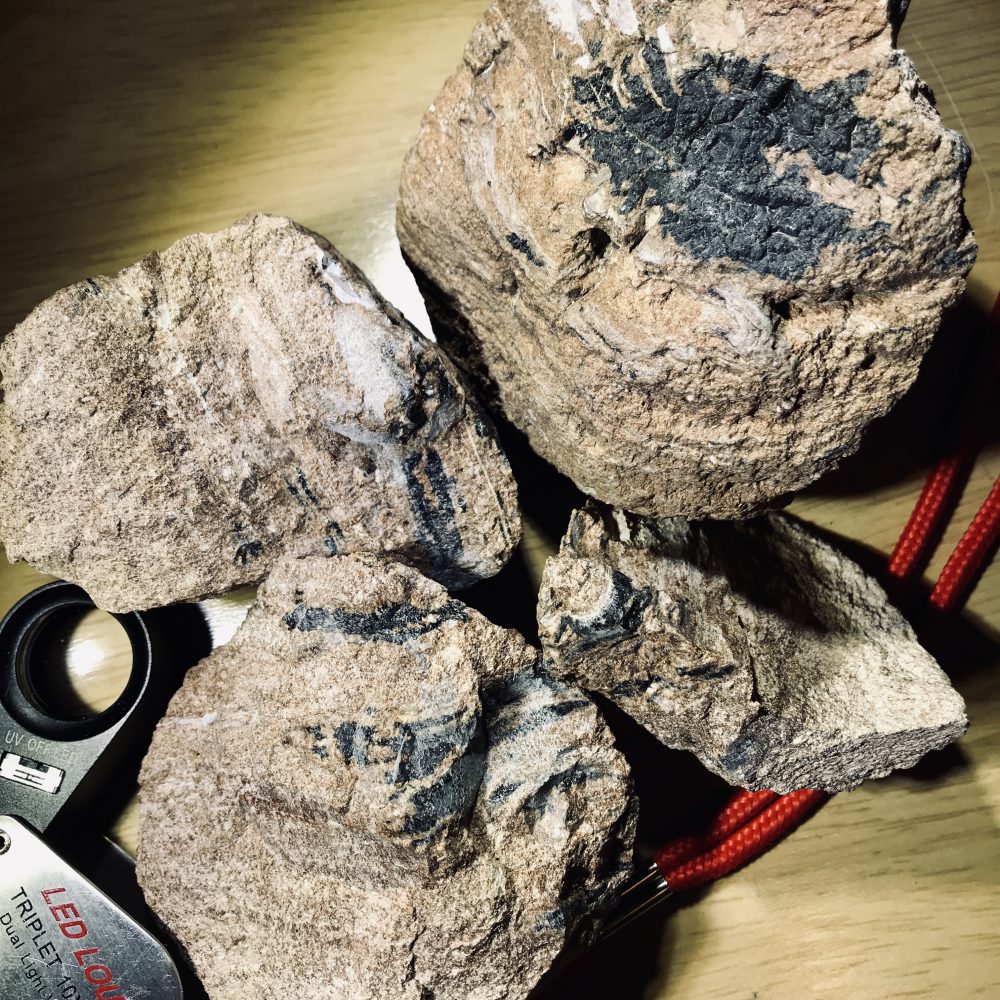Yesterday I went out to Lathrop Wells in Nye County looking for placer gold in featureless alluvium, possibly 240 deep where I was. I had the audio on my metal detector turned way down to save on battery life. I wasn’t listening for gold nuggets or gold in quartz that day, instead, I was reading the display on my Whites’ black sand tracker feature. It gives a numerical reading on any ground the coil is moving over. I sample when I see it go above 45, unfortunately, it only hit 42 once.
But one sandstone rock with black streaks blasted out despite the volume on the speaker being turned down. Well, I thought, that’s interesting. Aside from the possibility of gold, I wasn’t aware of any other metallic ore in this ocean of alluvium. No mining district here or any past mining activity. The signal sounded like the hot rocks I encountered everywhere in the the canyons of the forks of the American River. You get what sounds like a good signal and then you listen as the GMT cancels the signal out. I should explain.
A decent gold signal is a strong, low, mellow tone that happens each time the search coil passes over a rock. The signal remains no matter how many times the search coil goes over the target. What usually happens with a bad rock, often with an iron component, is that a signal is heard initially but that signal disappears after several passes. With each sweep the GMT is logging information to determine if a rock is ferrous or not. If so, the signal weakens and then goes away. This is called cancelling out. This rock did not cancel out. That’s what you look for with gold. Most non-metallic rocks are neutral and the GMT also passes them by without raising any signal.
The signal, however, was weak and wavy. Not good. You want to hear a steady signal, nice and low. You’ll rarely hear this. The Whites also has a probability of iron meter. It was reading at nearly 100%. Okay, I thought, this is coming home with me to figure out later. When I broke it open at home it revealed a dark material like that which it showed from the outside, hardness about three. Not attracted to a magnet, not even my super magnet. No U, no UV. Dull, off-white streak on a black streak plate. Metallic luster when freshly broken, annealed appearance in some spots with fresh breaks. Crushed and panned a piece, nothing unusual, no free gold at the macro or micro level.
To get the ID process going I mailed off a chip today by regular US mail to Kerry Day. He charges less than ten dollars for a seasoned opinion based his experience and the results produced by his electron scanning microscope and its supporting software. I’ve written about his service many times before. I taped a small chip to my business card, put it in a normal envelope and the charge for mailing was less than $2.50. Make sure your sample fits into a No 10 first class envelope, anything bigger might be considered a package and then mailing rates go up enormously.

My Falcon MD-20 handheld metal detector indicated that the material was non-ferrous, despite what my Whites said. Ferrous material produces a noise when an object goes away from the Falcon’s probe. Non-ferrous produces a signal as you move material toward the probe. This material only produced a signal going toward the probe, however, there are cases where a material is so strong that it may overwhelm the device and make it impossible to determine which is which. There were also some tiny gold colored spots arranged in lines here and there in the black material. On seeing gold coloring, always assume mica or pyrite. The nice thing about the Falcon handheld and the GMT is they do not react to pyrite. Never. I have lumps of pure pyrite and both devices stay silent when moved over that nonsensical material. Pyrite is an iron associate but too weakly so. Yet the rock continued sounding off. I suspect that it was is not those gold colored specks making the noise but the black material.
Unable to resolve the difference between the two metal detectors, I gathered up the rock pieces and went back to my truck and the GMT. I ran the coil over the rocks again. Sure enough, I hadn’t read the meter right in the field. This time the meter did not go above the halfway line, indicating something less than ferrous. The signal remained weak but still would not cancel out. Now, I just wanted to figure out what the material was, never mind that it wouldn’t be worth anything.
After further research I discovered that there are three long abandoned copper mines in the hills that drain to the wash I had been in. I still don’t know what that black material is but I am now convinced that I have a rock with copper. Not worth anything but a nice find. Those exploratory diggings are now unclaimed and the ground is on open BLM managed land. A little close to the Nevada Test Site boundary but at least a mile away. I may go exploring there to look for copper mineral specimens. Here’s a link to one mine listed at the the MRDS if you want to go:
Lucky Claim:
https://mrdata.usgs.gov/mrds/show-mrds.php?dep_id=10046589
Materials Type of material
Malachite Ore
Hematite Gangue
Fractured quartzsite with slight banding
Lathrop Wells Collecting from Thomas Farley on Vimeo.


